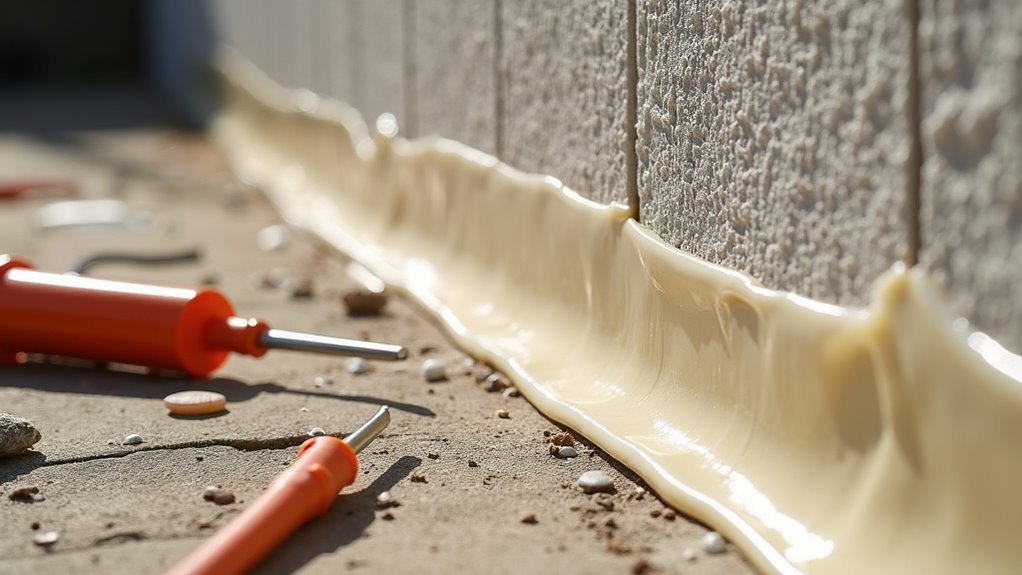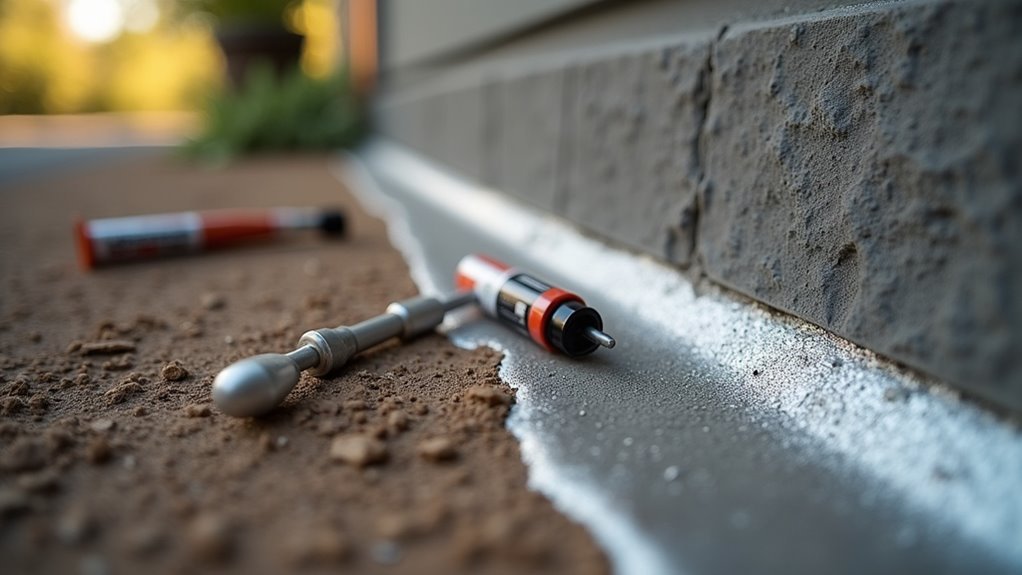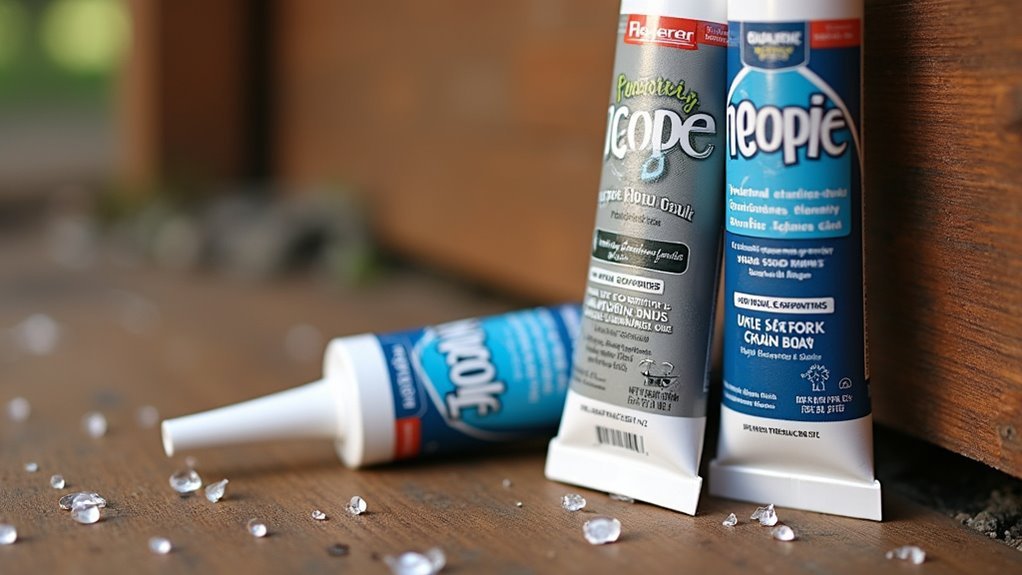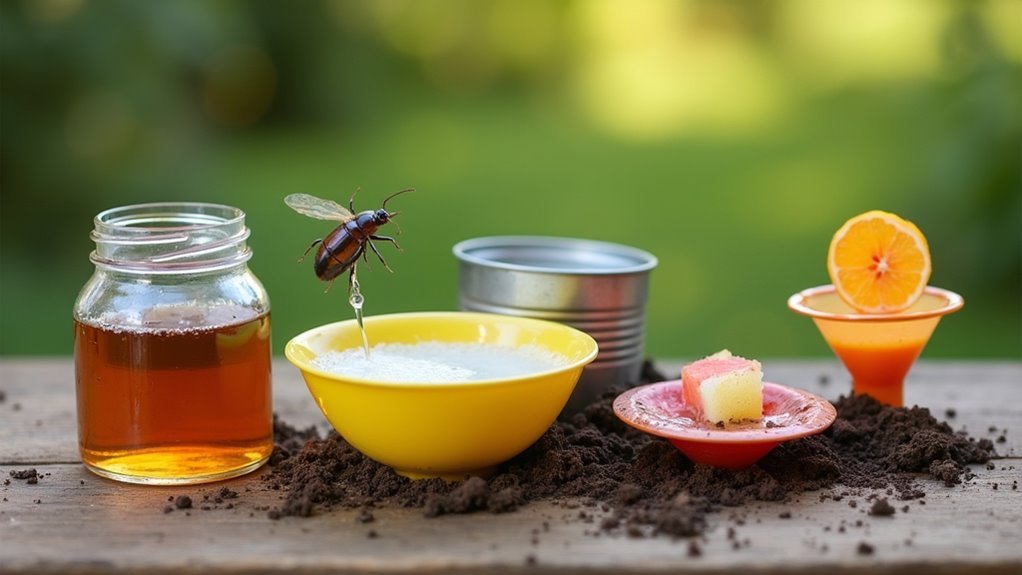You’ll want to evaluate three top foundation caulks for blocking mice: silicone-based sealants offer superior durability and flexibility while withstanding temperature changes without cracking. Steel wool combined with caulk creates a dual-layer barrier that’s effective for holes up to 1/4 inch, providing chew-resistant protection. Professional-grade barrier pastes with metal reinforcement work best for larger openings, containing metal fibers that create impenetrable barriers. Each option requires proper application techniques to maximize their protective potential.
Silicone-Based Sealants for Long-Term Foundation Protection

When protecting your foundation from rodent intrusion, silicone-based sealants offer superior durability and flexibility that traditional caulks simply can’t match.
These advanced sealants withstand temperature fluctuations without cracking, making them perfect for foundation applications where seasonal changes stress conventional materials.
You’ll create an effective waterproof barrier that blocks moisture while sealing small gaps mice exploit for entry. Silicone adheres strongly to concrete and masonry surfaces, preventing peeling that compromises rodent exclusion efforts.
The flexible nature maintains seal integrity despite structural movement.
For long-term protection, these sealants resist mold and mildew in damp foundation environments.
When properly applied, they last years without reapplication, making them cost-effective for sustained pest prevention.
You’ll prevent entry points from reopening, ensuring your foundation remains secure against unwanted rodent visitors.
Steel Wool and Caulk Combination Systems
While silicone sealants excel at protecting foundations, you’ll achieve maximum rodent protection by combining steel wool with caulk for a two-layer defense system.
For ultimate foundation protection against rodents, create a dual-layer barrier using steel wool beneath caulk sealant.
This mouse proofing technique works by stuffing steel wool into gaps around foundation entry points before applying foundation caulks over the top. The steel wool creates an effective barrier against rodent entry for holes up to 1/4 inch, while the caulk provides a chew-resistant seal that withstands outdoor conditions.
You’ll need to perform regular inspections since steel wool can rust when exposed to moisture, and caulk degrades over time.
For ideal pest control results, focus on sealing gaps around pipes, vents, and foundation cracks. This combination system delivers superior protection by preventing mice from gnawing through softer materials while maintaining long-term structural integrity.
Professional-Grade Barrier Pastes With Metal Reinforcement

For openings larger than 1/4 inch that require maximum protection, professional-grade barrier pastes with metal reinforcement offer superior defense against persistent rodents.
These specialized products contain metal fibers that create an impenetrable barrier rodents can’t chew through, unlike standard caulks that mice easily destroy.
You’ll need a caulking gun for application when sealing openings in foundation cracks and gaps. Fill each opening with at least ¾ inch depth to guarantee proper adhesion and effectiveness.
The waterproof formula withstands extreme temperatures while maintaining its protective properties.
What sets professional-grade barrier pastes apart is their metal shards that provide flexibility and expansion capabilities.
This design creates a robust defense that adapts to structural movement while remaining durable against rodent entry attempts, making them ideal for long-term foundation protection.
Frequently Asked Questions
How to Seal Foundation to Keep Mice Out?
You’ll need to inspect your foundation for cracks larger than 1/4 inch, then clean surfaces thoroughly. Apply high-quality silicone or polyurethane caulk using proper three-step sealing techniques for effective protection.
Can Mice Get Through Silicone Caulk?
Yes, mice can chew through silicone caulk since it’s not rodent-proof. You’ll need to combine silicone with steel wool or metal mesh for effective protection against mouse entry through foundation gaps.
How Do You Seal Gaps to Keep Mice Away?
You’ll seal gaps by first stuffing steel wool into openings, then applying silicone caulk over it. Focus on areas around pipes, foundation cracks, and entry points where mice commonly enter your home.
What Should I Block a Mouse Hole With?
You should block mouse holes with steel wool first, then apply silicone caulk around the edges. For larger openings, use metal sheeting or concrete patch covered with protective material for maximum effectiveness.
In Summary
You’ll find these three foundation caulking solutions offer different advantages for your mouse-proofing needs. Silicone-based sealants provide excellent weather resistance and flexibility. Steel wool combinations create immediate barriers that mice can’t chew through. Professional-grade metal-reinforced pastes deliver the strongest long-term protection. Choose based on your budget, DIY skills, and severity of your mouse problem. Don’t forget to inspect and reapply these solutions annually for maximum effectiveness.





Leave a Reply